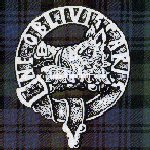Clan Campbell History
The ancestors of the Campbells were already great territorial Lords in Scotland, even before their emergence as a clan in the late twelve hundreds. They held lands in Perthshire, Clackmannan, Dunbarton, Ayr, and Argyll. The records of 1293 to 1296 show five knights of the family holding lands or office in Argyll alone.
The traditional Gaelic pedigrees give the origins of the family as being descended from the Britonic Celts of the Lennox, immediately to the east of Argyll and based upon the Dun of the Britons - now called Dunbarton Rock. The original family name was O'Duibne (pron. Oh doin). Probably about the time of the death of Somerled, Regulus of Argyll in 1163, Gillespic O'Duibne married Eva, a Dalriadic heiress of Lochawe in Argyll, whose father, Paul a Sparain, may well have been Treasurer of Somerled. Tradition holds that her mother was daughter of the King of Man.
The lands of Lochawe were likely confirmed and expanded during King Alexander's expedition to subdue Argyll in 1222, when Gillespic and Eva O'Duibne's son Duncan would have lived. He appears on record as Baron of Lochawe. His son, Dougall O'Duibne, is said to have been given the nickname Caim Beul , or "curved mouth," a physical description. He must have been much loved by his sons for all of them took Cambel as their family name within the O'Duibne kin. Dougall's second son, Sir Gillespic Campbell of Lochawe, married Efferick, granddaughter of Duncan, Earl of Carrick, who's great - grandson would be King Robert the Bruce. This royal kinship, reinforced by later marriages of Campbell Chief's to Stewart daughters, obliged the Campbells to take up as their national role the protection of the royal house and realm from risings in the west. In this, they were consistent until the Reformation of 1560. After which, they held the support of the reformed religion in the face of royal changes of faith, supporting Protestant succession.
The defeat of the MacDougall heirs of Somerled, Lords of Argyll, by Bruce and his MacDonald and Campbell allies in 1308, began the rise of power of Donald and Campbell alike. But soon Clan Donald, younger cousins of Clan Dougall, became a great power in the Isles and a threat to the realm, at one point making treaty with the English to overthrow the King of Scots. This pitted Campbell and MacDonald against each other and so began their traditional roles as rivals.
Clan Campbell were rewarded for their loyalty to the crown by repeated royal grants of lands which enabled younger sons of the Chiefly kin to be set up on farms, founding more than 200 branches of the clan who were ennobled by grants of arms. This burgeoning growth brought growing power, envied by some, enjoyed by those under Campbell protection, but also feared by many, sometimes with reason and sometimes without. Inevitably, as leading defenders of the realm in the west, the Campbell Chiefs were obliged to balance some feudal influences of the crown with their older and deeply imbued Celtic culture of the Gael in Argyll. Like the Lords of the Isles, they accepted and granted charters giving authority over those who considered themselves as belonging to the lands named in them. Yet, they long used the Norse and feudal concept of primogeniture only when it was convenient. Several times, the best ‐ not the eldest - succeeded as Chief.
Less fortunate clans have had modern proponents who tried to explain Campbell successes by making out that the Campbells were not of the culture of the Gael. But, despite their early cousinly origins among the Britonic Celts, the facts of history show that in the Dalriadic heartland of Argyll and Perthshire, in the ancient Gaelic pedigrees, their Gaelic bards and music, and in their holding to such customs as fostering and tanistry even into the 18th century, the Chiefs and people of the clan were steeped in the customs and traditions of the Gael.




 Clan Campbell Society (North America)
Clan Campbell Society (North America)